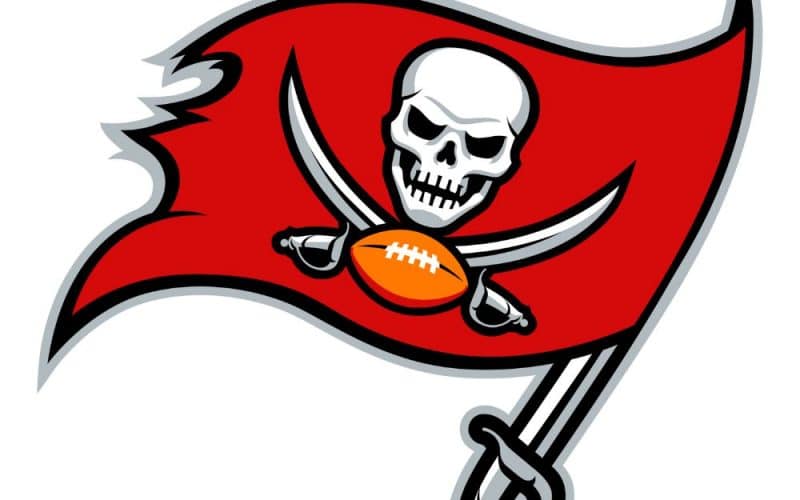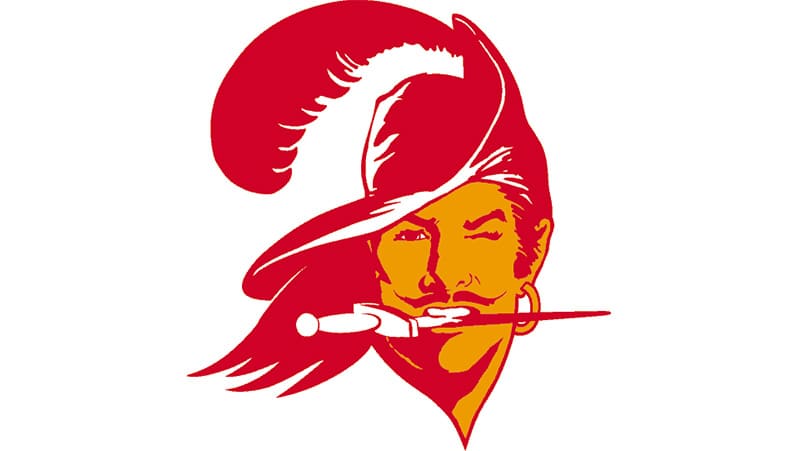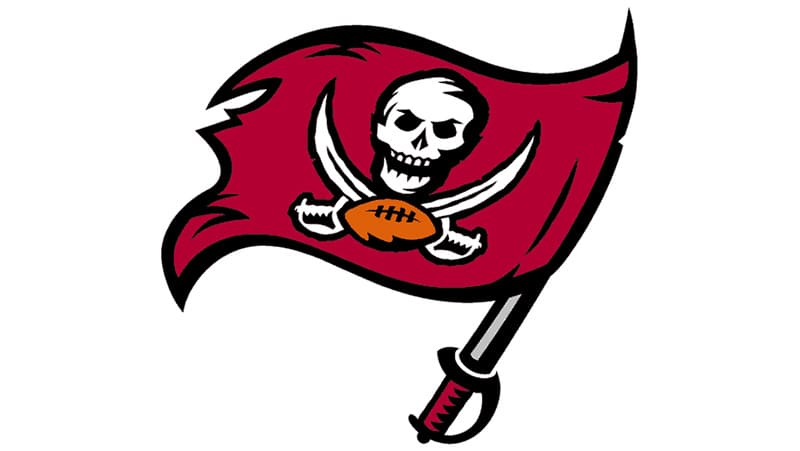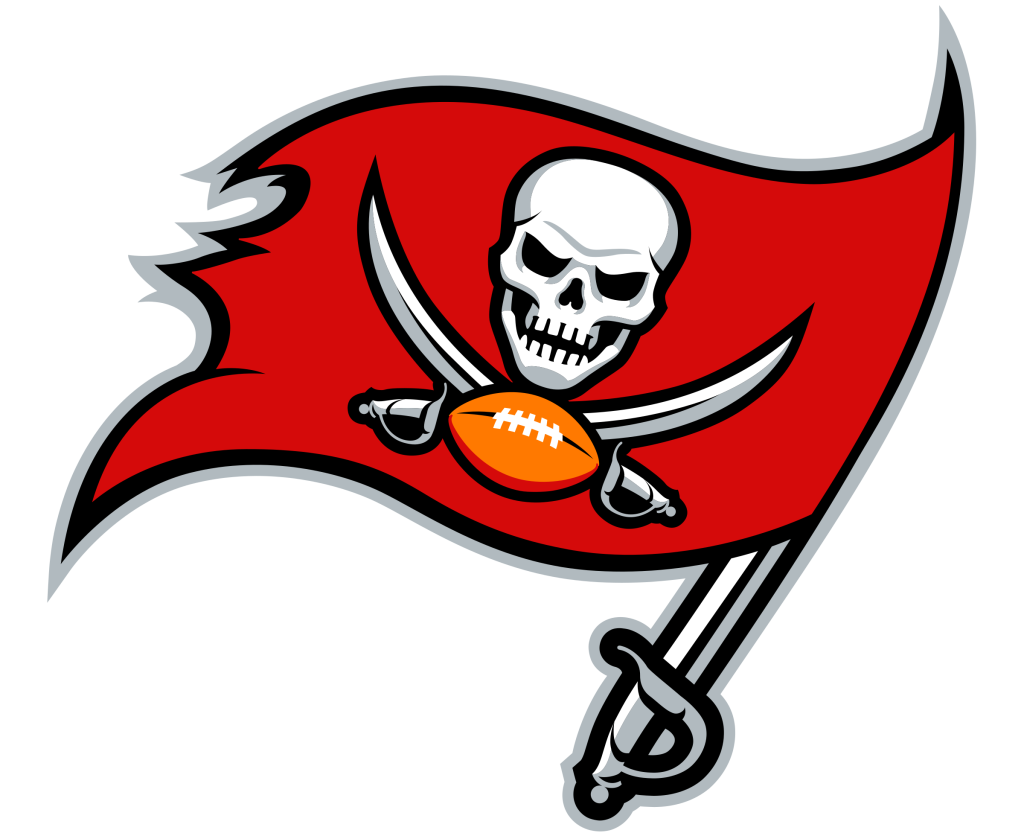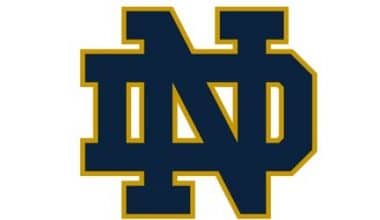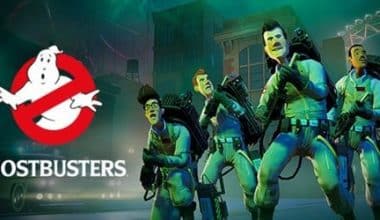The Tampa Bay Buccaneers have a long and storied history, first appearing in the NFL in 1976 and bringing with them one of the most unique logos at the time. Popularly known as the “Bucco Bruce,” the logo featured a pirate with a knife in his mouth. And while it was not overly intimidating, the logo gave the Bucs a great look that lasted through 1996.
The team’s logo was inspired by its name and hasn’t gone through many redesigns over the years. There are only two variants of the logo design, with the first one portraying a pirate portrait and a flag logo modified slightly throughout the years. The main colour scheme has always been red, symbolizing power and passion.
The current Buccaneers logo was designed in 2014 and features the team’s classic red, windswept battle flag, featuring a more frightening skull placed above a football and crossed swords. According to Buccaneers Co-chairman Edward Glazer, the new changes set the team up nicely to transition into an exciting and new era of American football.
Tampa Bay also introduced new uniforms that spotted a modernized logo in 2014. It had a brighter red shade, an orange tertiary colour, oversized helmet decals, a unique number typeface, and the first-ever NFL chrome facemask.
History of the Tampa Bay Buccaneers
The Tampa Bay Buccaneers are a professional American football team based in Tampa, Florida. They compete in the National Football League (NFL) as a member club of the league’s National Football Conference (NFC) South division.
The club joined the NFL in 1976 as an expansion team, along with the Seattle Seahawks, and played its first season in the American Football Conference (AFC) West division. Before the 1977 season, Tampa Bay switched conferences and divisions with Seattle, becoming a member of the NFC Central division. As a result of the league’s realignment before the 2002 season, the Buccaneers joined three former NFC West teams to form the NFC South.
The Buccaneers have won two Super Bowl championships and, along with the Baltimore Ravens, are the only two NFL franchises who are undefeated in multiple Super Bowl appearances. They were regarded as a perennial losing franchise for most of their first two decades due to suffering 26 consecutive losses in their first two seasons (including a winless inaugural season) and 14 consecutive losing seasons from 1983 to 1996—the most in NFL history—and contributing to their league-worst overall winning percentage at .404.
Despite these early struggles, Tampa Bay is the first post-merger expansion team to clinch a division title, win a playoff game, and host a conference championship, all of which they accomplished by their fourth season in 1979. The team’s image improved by the time of their first championship in 2002, also the first for a franchise built after the merger.
However, they would not win another playoff game until their second Super Bowl championship season in 2020.
The club is owned by the Glazer family and plays its home games at Raymond James Stadium in Tampa.
History of the Tampa Bay Buccaneers logo
After its introduction into the NFL, the team commissioned cartoonist Lamar Sparkman to design their first logo. Lamar was working as a graphic designer for the Tampa Bay Buccaneers at the time. He designed a logo that featured a pirate named Bucco Bruce, who wore a wide-brimmed hat and clenched a knife in his mouth.
The logo served the team for 20 years before being replaced by Jolly Roger in the logo.
The attractive colour palettes on the team’s logo have existed since the first day. Although the composition of the emblem has changed over time, the Buccaneers’ spirit of freedom and aesthetics remained.
The Tampa Bay Buccaneers logo features a unique colour palette of fluorescent red and orange, which is a nod to the warmth of Florida’s sunshine and its citrus industry. The colour scheme also symbolizes the team’s “courage and grit in battle.”
Here is a timeline of how the logo has changed over the years:
Tampa Bay Buccaneers logo from 1976 to 1996
The first-ever Tampa Bay Buccaneers logo was designed in 1976 by cartoonist Lamar Sparkman. The logo features a pirate whose face has some shades of red and yellow. The pirate holds a knife with a white handle and red blades with his teeth and has a large hoop earring. He also has a plumed slouch hat with a giant red feather at the top.
The pirate appears to be winking, which helps combine the element of danger with playfulness.
Tampa Bay Buccaneers logo from 1997 to 2013
In 1997, the Buccaneers were modified, seeing its most tremendous change in history. The pirate was replaced by a Buccaneer burgundy flag bearing a white Jolly Roger image in it. Also, the flag had a yellow football with black stitches placed under the skull and crossed swords. The flag’s handle features a sword grey and red.
The end product was the first version of the logo that exists to date.
Tampa Bay Buccaneers logo from 2014 to 2019
2014 saw an update in the colour palette of the emblem and its contours. The skull’s shape was made smoother, making it look scarier. The football’s stitches were changed from black to white, and a lighter shade of red replaced the flag’s burgundy colour. The flag’s outlines were made thinner, and the red and grey sabre’s handle was made silver-grey.
The end product was a more professional and elegant-looking logo.
Tampa Bay Buccaneers logo from 2020 – Today
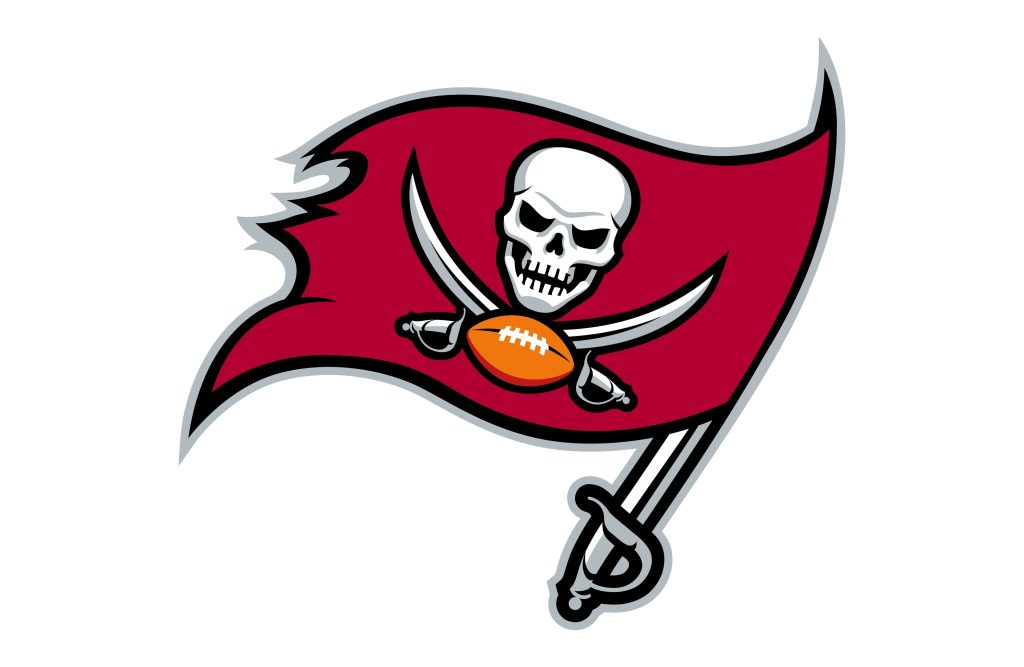
The 2020 redesign of the logo saw the return of the burgundy colour on the flag, with the other elements remaining the same. This means that the yellow football with white stitches, the white Jolly Roger, and the silver-grey sword’s handle all remained.
Elements of the Tampa Bay Buccaneers logo
Over the years, the Tampa Bay Buccaneers logo has seen several redesigns. Today’s emblem is entirely different from Lamar Sparkman’s first version, which featured a pirate clenching a dagger in his teeth. The logo, which appeared in April 1975, was replaced by a football-inspired Jolly Roger image in 1996.
The second version of the emblem was inspired by Calico Jack, a famous 18th-century pirate, hence the skull on a football placed between crossed swords. Over the years, Tampa Bay Buccaneers have updated their logo to represent them as a team. Today, the logo appears scarier but in a cartoonish manner.
A great logo is identified through its elements, including colour, shape, size, typography, tone, etc. Here is a look at the current Tampa Bay Buccaneers logo elements.
- Shape. The first Buccaneers logo was not a shape but rather the face of a pirate to symbolize toughness. Today, the logo is rectangular, signifying stability, solidity, and honesty.
- Colour. Throughout the Buccaneers logo, only a few colours have been dominant, including red (right red and burgundy), yellow, silver-grey, and white. Currently, the logo is burgundy, differing from the 2014’s by the shades of red only. The skull and the swords are white, with silver-grey shading to give them volume. Since 1996, football has been yellow. The logo has a black outline, except for the flag’s grey outline and handles.
Generally, the colour red/burgundy has been used to symbolize the team’s “courage and fortitude in battle.”
Early history of the Tampa Bay Buccaneers to the present
Inception to 1990
The Buccaneers (often called “Bucs”) were founded in 1976 and posted an ignominious 0-14 record during their maiden NFL season. After taking part in the AFC (American Football Conference) in their first season, the Buccaneers shifted to their present conference in 1977.
Tampa Bay Buccaneers continued their losing streak in the NFC (National Football Conference) as it wasn’t until December 1977 that they won their first match. Their 26-game losing run is still an NFL record in the Super Bowl period (1966 to today).
The early Bucs sides were recognizable thanks to the presence of the charming Coach John McKay and defensive end stalwart and future Hall of Famer Lee Roy Selmon. McKay’s numerous quips about the Bucs’ struggles endeared him to all football fans in the country.
In 1979, under quarterback Doug Williams’ captaincy, the Buccaneers shocked many observers by winning ten games and qualifying for the postseason, in which they made it to the conference title decider but lost to the Los Angeles Rams. The Bucs went on to clinch two playoff spots in 1981 and 1982 but dropped back down to the foot of the conference table in 1983 with a record of 2-14.
The 1983 season started an embarrassing streak of 14 successive seasons in which the Bucs posted double-figure loss totals. Throughout that period, the Bucs had an unlucky habit of bringing in numerous high-profile stars (including quarterbacks Vinny Testaverde and Steve Young) who would flop or not play at all, only to leave and then enjoy immense success with other sides.
1990 to 2010
In the late 1990s, the Buccaneer’s fortunes started to turn around as Coach Tony Dungy assembled one of the best defences in the football league, featuring linebacker Derrick Brooks, tackle Warren Sapp, as well as defensive backs Ronde Barber and John Lynch. In five seasons between 1997 and 2001, the team made four appearances in the postseason. However, due to a weak offence, they scored less than 10 points in every one of its four playoff losses during that period.
Despite his season-on-season success, Dungy was sacked in early 2002.
Coach Jon Gruden was brought in to improve the Bucs’ offence. Thanks to boasting the best defence in the NFL, the team was able to post a record of 12-4 in 2002 (the joint-best record in the league) and upset the Philadelphia Eagles in an NFC title match in January 2003.
At the Super Bowl XXXVII, the Tampa Bay Buccaneers resoundingly beat the Oakland Raiders 48-21 and won their first title. The Buccaneers didn’t make it to the postseason for the next two years but advanced to the playoffs at the end of both the 2005 and 2007 campaigns, both of which resulted in opening-round defeats at home.
In 2008, a late-season implosion by the Bucs—they lost four straight games to finish the campaign after beginning 2008 at 9-3—resulted in the sacking of Coach Gruden and wide-ranging management, coaching, and roster turnover all in a bid to rebuild the team from scratch.
2010 to 2020
While the Buccaneers won 10 matches in 2010 (but failed to advance to the playoffs), that massive rebuilding effort ultimately yielded no fruit.
The Bucs followed this up by surprisingly hiring college football trainer Greg Schiano, who presided over two losing campaigns that included several embarrassing lows—not least an MRSA outbreak in the changing room—before being shown the door at the close of the 2013 campaign.
The Bucs rebuilt around youthful quarterback Jameis Winston, which led them to post their first winning record in 2016 after six seasons. But the revival proved short-lived, and the side posted back-to-back, losing records of 5-11 in both 2017 and 2018.
Tampa Bay Buccaneers signed former Arizona Cardinals trainer Bruce Arians to a 4-year contract in the off-season of 2019, coaxing him out of retirement in the process. Some notable off-season signings for the Bucs included linebackers Deone Bucannon and Shaquil Barret, offensive tackle Donovan Smith, as well as Breshad Perriman (their former starting wide receiver).
In Arians’ first campaign coaching the Buccaneers, Jameis Winston was expected to improve the team’s play. The team ended their season with a 7-9 record, including a run of four successive wins between week 12 and 15. Winston finished his season with more than 5,000 passing yards, 30 interceptions, and 33 touchdowns, becoming the first-ever NFL quarterback to simultaneously post at least 30 interceptions and touchdowns in the same campaign.
2020 to present
In the off-season of 2020, the Buccaneers decided to phase out quarterback Jameis Winston. They went ahead to draft six-time Super Bowl winner and long-serving New England Patriots star Tom Brady in his place on a two-year $50 million contract, with $4.5 million in bonuses per year, too. Later on, Brady was joined by Patriots defensive end Rob Gronkowski, who had earlier retired.
In the 2020 season, Tom Brady went on to lead the Bucs to a winning 11-5 record as well as a playoff spot for the first time in 13 years. The Bucks knocked out the Washington Football Team to get their first postseason win since their 2002 Super Bowl-winning campaign and then proceeded to beat their division foes New Orleans Saints before eliminating top-seeds Green Bay Packers to clinch their first NFC championship in 18 years.
The Bucs then qualified for Super Bowl LV to face the Kansas City Chiefs. In the process, they became the first wildcard side to advance to the Super Bowl championship in 10 years since the Green Bay Packers clinched Super Bowl XLV in 2010. In addition, the Bucs became the first-ever NFL team to fight for the Super Bowl at home.
The Bucs ended up crushing the Kansas City Chiefs 31-9 to win their second Super Bowl title. At the same time, Tom Brady bagged his record fifth NFL Super Bowl Most Valuable Player award.
Recommended Articles
- TAMPA BAY LIGHTNING LOGO: History and Everything you Need to Know
- PACKERS LOGO: Green Bay Packers History and Timeline
- The Cost of Going to an NFL Game – Is It Worth It?
- ASTROS LOGO: Houston Astros Teams History and Facts
- NFL LOGO: Meaning, Evolution, and History
- NASCAR LOGO: Nascar Race Car History & Specifications
